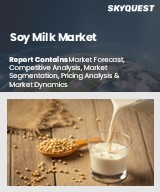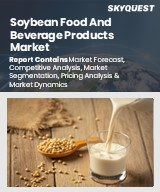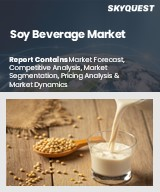
|
시장보고서
상품코드
1785650
두유 시장 규모, 점유율, 성장 분석, 유형별, 카테고리별, 용도별, 유통 채널별, 지역별 - 산업 예측(2025-2032년)Soy Milk Market Size, Share, and Growth Analysis, By Type (Plain, Flavoured), By Category (Conventional, Organic), By Application, By Distribution Channel, By Region Industry Forecast 2025-2032 |
||||||
세계 두유 시장 규모는 2023년 103억 달러, 2024년 109억 8,000만 달러에서 2032년에는 161억 7,000만 달러로 성장하고, 예측 기간(2025-2032년) CAGR은 6.66%를 보일 전망입니다.
세계 두유 부문은 소비자의 건강 인식 증가, 유당 불내증 인구 증가, 식물성 단백질 대체품에 대한 수요 증가로 인해 성장할 것으로 예측됩니다. 영양 및 건강 지향적 트렌드는 소비자의 기호를 클린 라벨, 저지방, 기능성 음료로 전환하여 두유에 대한 수요를 크게 증가시켰습니다. 두유는 콜레스테롤을 낮추고 전반적인 심장 건강에 도움이 되는 것으로 유명하며, 완전한 아미노산 프로파일을 제공하기 때문에 유제품 대안을 찾는 사람들에게 매력적이고 지속 가능한 단백질 공급원이 되고 있습니다. 그러나 아몬드 우유, 오트밀 우유와 같은 경쟁 식물성 우유, 유전자 변형 콩에 대한 우려, 콩 가격 변동, 전통 유제품에 대한 선호도 지속 등의 문제에 직면해 있어 시장 성장을 저해할 수 있습니다.
목차
서론
- 조사 목적
- 조사 범위
- 정의
조사 방법
- 정보 조달
- 1차와 2차 데이터 방법
- 시장 규모 예측
- 시장 전제조건과 제한
주요 요약
- 세계 시장 전망
- 공급과 수요 동향 분석
- 부문별 기회 분석
시장 역학과 전망
- 시장 개요
- 시장 규모
- 시장 역학
- 성장 촉진요인과 기회
- 성장 억제요인과 과제
- Porter의 Five Forces 분석
주요 시장 인사이트
- 중요 성공 요인
- 경쟁 정도
- 주요 투자 기회
- 시장 생태계
- 시장의 매력 지수(2024년)
- PESTEL 분석
- 거시경제 지표
- 밸류체인 분석
- 가격 분석
- 이용 사례
- 고객 구매 행동 분석
두유 시장 규모 : 유형별&CAGR(2025-2032년)
- 시장 개요
- 플레인
- 플레이버
- 기타
두유 시장 규모 : 카테고리별&CAGR(2025-2032년)
- 시장 개요
- 기존
- 오가닉
두유 시장 규모 : 용도별&CAGR(2025-2032년)
- 시장 개요
- 치즈 및 디저트
- 스낵
- 음료
두유 시장 규모 : 유통 채널별&CAGR(2025-2032년)
- 시장 개요
- 점포
- 비점포
두유 시장 규모&CAGR(2025-2032년)
- 북미
- 미국
- 캐나다
- 유럽
- 독일
- 스페인
- 프랑스
- 영국
- 이탈리아
- 기타 유럽
- 아시아태평양
- 중국
- 인도
- 일본
- 한국
- 기타 아시아태평양
- 라틴아메리카
- 브라질
- 기타 라틴아메리카
- 중동 및 아프리카
- GCC 국가
- 남아프리카공화국
- 기타 중동 및 아프리카
경쟁 정보
- 주요 5개사 비교
- 주요 기업의 시장 포지셔닝(2024년)
- 주요 시장 기업이 채택한 전략
- 최근 시장 동향
- 기업의 시장 점유율 분석(2024년)
- 주요 기업 개요
- 기업 상세
- 제품 포트폴리오 분석
- 기업 부문별 점유율 분석
- 매출 전년대비 비교(2022-2024년)
주요 기업 개요
- Eden Foods Inc
- Organic Valley
- Pureharvest
- American Soy Products
- Vitasoy International Holdings
- Sunopta Inc
- Pacific Natural Foods
- Sanitarium
- Hain Celestial Group Inc
- Danone S.A.
- The Hershey Company
결론과 제안
LSH 25.08.13Global Soy Milk Market size was valued at USD 10.3 Billion in 2023 and is poised to grow from USD 10.98 Billion in 2024 to USD 16.17 Billion by 2032, growing at a CAGR of 6.66% during the forecast period (2025-2032).
The global soy milk segment is poised for growth due to rising health awareness among consumers, an increasing population with lactose intolerance, and a growing demand for plant-based protein alternatives. The trend towards nutrition and wellness has shifted consumer preferences towards clean-label, low-fat, and functional beverages, significantly boosting soy milk demand. Renowned for its cholesterol-lowering properties and overall heart health benefits, soy milk offers a complete amino acid profile, making it an appealing, sustainable protein source for those seeking dairy alternatives. However, the market faces challenges from competing plant-based options like almond and oat milk, concerns around genetically modified soybeans, fluctuating soybean prices, and a continued preference for traditional dairy products, potentially constraining its growth.
Top-down and bottom-up approaches were used to estimate and validate the size of the Soy Milk market and to estimate the size of various other dependent submarkets. The research methodology used to estimate the market size includes the following details: The key players in the market were identified through secondary research, and their market shares in the respective regions were determined through primary and secondary research. This entire procedure includes the study of the annual and financial reports of the top market players and extensive interviews for key insights from industry leaders such as CEOs, VPs, directors, and marketing executives. All percentage shares split, and breakdowns were determined using secondary sources and verified through Primary sources. All possible parameters that affect the markets covered in this research study have been accounted for, viewed in extensive detail, verified through primary research, and analyzed to get the final quantitative and qualitative data.
Global Soy Milk Market Segments Analysis
The Global soy milk market is segmented by type, category, application, distribution channel and region. Based on type, the market is segmented into plain, flavored and others. Based on category, the market is segmented into conventional and organic. Based on application, the market is segmented into cheese and desserts, snacks, and beverages. Based on distribution channel, the market is segmented into store-based and non-store-based. Based on region, the market is segmented into North America, Europe, Asia Pacific, Latin America and the Middle East and Africa.
Driver of the Soy Milk Market
The growing recognition of soy milk's nutritional benefits has positioned it as a leading alternative to traditional dairy products. Its high-quality protein content, presence of isoflavones, and low cholesterol levels make it an appealing choice for health-conscious consumers. As public awareness surrounding health and wellness expands, soy milk is increasingly favored for its potential to support weight management and hormonal balance. Additionally, the rising prevalence of lifestyle-related health issues, such as lactose intolerance, obesity, and cardiovascular conditions, significantly boosts the demand for soy milk, particularly in urban areas where health trends are rapidly adopted.
Restraints in the Soy Milk Market
The Global soy milk market faces significant challenges due to the increasing availability and popularity of alternative plant-based beverages, such as almond, oat, coconut, and rice milk. Consumers are increasingly drawn to these options for their unique flavors, textures, and perceived environmental benefits. As the demand for these alternatives rises, the shelf space allocated to them in retail outlets has expanded, thereby reducing the visibility and availability of soy milk. This shift in consumer preferences and retail strategies has made it more difficult for soy milk to maintain its status as a leading dairy alternative in an ever-evolving market landscape.
Market Trends of the Soy Milk Market
The Global soy milk market is experiencing significant growth, fueled by a pronounced consumer shift towards healthier, plant-based alternatives. This trend is largely driven by the increasing awareness of soy milk's nutritional benefits, such as its high protein content and isoflavones, which are linked to lowering blood cholesterol levels and promoting cardiovascular health. As individuals seek to enhance their diets while addressing health concerns and environmental sustainability, soy milk emerges as a popular choice. The expanding variety of flavored and fortified options further appeals to diverse consumer preferences, solidifying soy milk's place in the evolving landscape of dairy alternatives.
Table of Contents
Introduction
- Objectives of the Study
- Scope of the Report
- Definitions
Research Methodology
- Information Procurement
- Secondary & Primary Data Methods
- Market Size Estimation
- Market Assumptions & Limitations
Executive Summary
- Global Market Outlook
- Supply & Demand Trend Analysis
- Segmental Opportunity Analysis
Market Dynamics & Outlook
- Market Overview
- Market Size
- Market Dynamics
- Drivers & Opportunities
- Restraints & Challenges
- Porters Analysis
- Competitive rivalry
- Threat of substitute
- Bargaining power of buyers
- Threat of new entrants
- Bargaining power of suppliers
Key Market Insights
- Key Success Factors
- Degree of Competition
- Top Investment Pockets
- Market Ecosystem
- Market Attractiveness Index, 2024
- PESTEL Analysis
- Macro-Economic Indicators
- Value Chain Analysis
- Pricing Analysis
- Case Studies
- Customer Buying Behavior Analysis
Global Soy Milk Market Size by Type & CAGR (2025-2032)
- Market Overview
- Plain
- Flavoured
- Others
Global Soy Milk Market Size by Category & CAGR (2025-2032)
- Market Overview
- Conventional
- Organic
Global Soy Milk Market Size by Application & CAGR (2025-2032)
- Market Overview
- Cheese and Desserts
- Snacks
- Beverages
Global Soy Milk Market Size by Distribution Channel & CAGR (2025-2032)
- Market Overview
- Store-Based
- Non-Store-Based
Global Soy Milk Market Size & CAGR (2025-2032)
- North America (Type, Category, Application, Distribution Channel)
- US
- Canada
- Europe (Type, Category, Application, Distribution Channel)
- Germany
- Spain
- France
- UK
- Italy
- Rest of Europe
- Asia Pacific (Type, Category, Application, Distribution Channel)
- China
- India
- Japan
- South Korea
- Rest of Asia-Pacific
- Latin America (Type, Category, Application, Distribution Channel)
- Brazil
- Rest of Latin America
- Middle East & Africa (Type, Category, Application, Distribution Channel)
- GCC Countries
- South Africa
- Rest of Middle East & Africa
Competitive Intelligence
- Top 5 Player Comparison
- Market Positioning of Key Players, 2024
- Strategies Adopted by Key Market Players
- Recent Developments in the Market
- Company Market Share Analysis, 2024
- Company Profiles of All Key Players
- Company Details
- Product Portfolio Analysis
- Company's Segmental Share Analysis
- Revenue Y-O-Y Comparison (2022-2024)
Key Company Profiles
- Eden Foods Inc
- Company Overview
- Business Segment Overview
- Financial Updates
- Key Developments
- Organic Valley
- Company Overview
- Business Segment Overview
- Financial Updates
- Key Developments
- Pureharvest
- Company Overview
- Business Segment Overview
- Financial Updates
- Key Developments
- American Soy Products
- Company Overview
- Business Segment Overview
- Financial Updates
- Key Developments
- Vitasoy International Holdings
- Company Overview
- Business Segment Overview
- Financial Updates
- Key Developments
- Sunopta Inc
- Company Overview
- Business Segment Overview
- Financial Updates
- Key Developments
- Pacific Natural Foods
- Company Overview
- Business Segment Overview
- Financial Updates
- Key Developments
- Sanitarium
- Company Overview
- Business Segment Overview
- Financial Updates
- Key Developments
- Hain Celestial Group Inc
- Company Overview
- Business Segment Overview
- Financial Updates
- Key Developments
- Danone S.A.
- Company Overview
- Business Segment Overview
- Financial Updates
- Key Developments
- The Hershey Company
- Company Overview
- Business Segment Overview
- Financial Updates
- Key Developments















